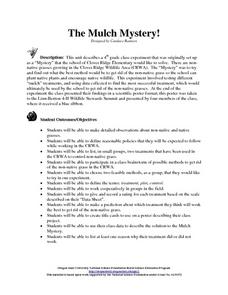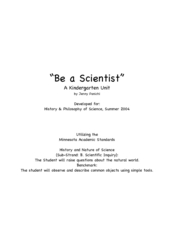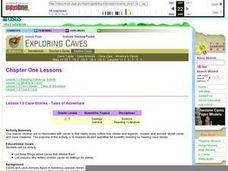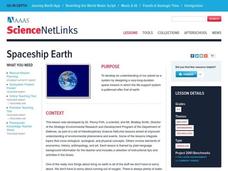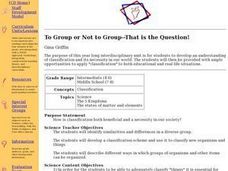EngageNY
How to Write Like a Scientist in the Field: Introduction to the Elements of Field Journals
It's time to start journaling. Scholars look at examples of science field journals. They work in pairs to examine and complete a note catcher about a field journal. They then add to an anchor chart by discussing the different features...
Curated OER
The Mulch Mystery!
Fourth graders make a detailed observations about non-native and native grasses. They define reasonable policies that they expect to follow while working in the CRWA. Students list, in small groups, two treatments that have been used in...
Curated OER
Whodunnit?
Want to create an exciting mystery activity? Investigators will identify the elements of a mystery, review mystery stories, then write their own mysteries. They engage in forensic science experiments related to mysteries and learn to ask...
Towson University
Case of the Crown Jewels
Can your biology class crack the Case of the Crown Jewels? Junior forensics experts try their hands at DNA restriction analysis in an exciting lab activity. The lesson introduces the concept of restriction analysis, teaches pipetting and...
Curated OER
Unraveling the Mysteries of Objects in Space
Students study emitted and absorbed light, and label each type of spectrum. They identify elements by their spectral signatures and use a spectroscope.
Curated OER
History/Mystery: Regionalism and Ethnicity in the American Detective Novel
Learners use mystery novels to focus on the history and ethnicity of different regions of the United States. As a class, they are introduced to the elements of a mystery and compare them to the other types of novels they have read. In...
Curated OER
once and future MOON
Beyond the phases of the moon, this comprehensive lesson plan covers geologic history and geology. Amateur astronauts examine photos of the lunar landscape, experiment with the creation of craters, and delve into information about the...
Curated OER
Naturally Magnetic Elements
Students explore naturally magnetic elements. For this magnets lesson, students examine the periodic table of elements. Students discover the parts of an atom and determine which three elements are magnetic.
Curated OER
Exploring Meteorite Mysteries: Building Blocks of Planets
Students simulate the formation of chondrites and asteroids. In this astronomy lesson, students demonstrate accretion using balloons and static electricity. They compare and contrast their models to the actual process of chondrites and...
Curated OER
Be a Scientist: A Kindergarten Unit
Students conduct observations using their five senses. In this science lesson plan, students describe different states of matter. They investigate the factors affecting mold growth.
Curated OER
Chemicals, Chemicals, Everywhere
Students divide substances into categories: made of chemicals/not made of chemicals, synthetic/naturally occurring, and toxic/nontoxic. They observe a mystery chemical and determine what precautions they need to take when handling an...
Community Resources for Science
Spring Mechanics
Scholars practice calculating spring constants before performing hands-on experiments. They compare data for parallel and series springs. Finally, they learn how spring mechanics find applications in biotechnology, such as prosthetic limbs.
Curated OER
Cave Stories - Tales of Adventure
Students list three things about caves that interest them and list reasons why writers choose caves as settings for stories.
Curated OER
What is That White Stuff?
Fifth graders identify, through experimentation, what properties of substance are, determine what variables tested will be, identify constants and variables of experiment, conduct experiment to conclusion with measurable, recorded...
Curated OER
Investigating Chemical and Physical Changes
Young scholars explore physical and chemical changes by looking at how different powders react to a variety of substances. They observe and identify the difference between physical and chemical change using a mystery powder.
Curated OER
Reading The Periodic Table
Eighth graders examine the Periodic Table. In this science lesson plan, 8th graders categorize a group of shells and unknown elements using different characteristics as they read and interpret the Periodic Table.
Curated OER
The Airplane
Students demonstrate the Bernoulli Principle, review the influences that affected the Wright Brothers, and make and modify paper airplanes. This amazing lesson plan has an excellent structure, and very clear plans for the students to...
Curated OER
Enigmas
Learners research "mystery" topics such as Easter Island, Bermuda Triangle and the Loch Ness Monster. Students brainstorm mysteries and explore the one of their choosing. They write a short report and share what they have learned with...
Curated OER
Living With Risk: The Human Element of Natural Disasters
Seventh graders research the Internet and the given websites to complete this activity. In this investigating natural disasters activity students complete several activities about natural disasters.
Curated OER
Spaceship Earth
Students develop an understanding of our planet as a system by designing a very-long-duration space mission in which the life-support system is patterned after that of earth.
Curated OER
A Little Mystery and Intrigue in Writing Short Detective Stories
Students read and analyze the twelve short stories in the novel "The Adventures of Sherlock Holmes." They create their own detective that has to solve a new kind of crime, and write and edit a short story with their original detective as...
Curated OER
To Group of Not to Group - That is the Question!
Upper elementary and middle schoolers use their observation skills to group different kinds of candy by similar characteristics. They debate whether or not we should classify objects. Finally, they learn that biologists have developed a...
Curated OER
Cave Diagram
Students examine limestone cave geology and hydology. They study cave vocabulary.
Curated OER
Chromosome Fusion
Students see how patterns can reveal events of the past, thereby merging elements of both experimental and historical science.



